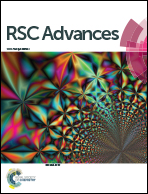PSA modified 3 D flower-like NiCo2O4 nanorod clusters as anode materials for lithium ion batteries
Abstract
Novel 3-dimensional (3 D) flower-like NiCo2O4 (NCO) nanorod clusters are fabricated by a facile hydrothermal process using styrene–acrylonitrile copolymer (PSA) nanospheres as a complex agent. The structure and morphology of NCO are characterized with X-ray diffraction (XRD), scanning electron microscopy (SEM) and transmission electron microscopy (TEM). The results show that the PSA modified NCO (PNCO) exhibits excellent electrochemical performance. Compared with pure NCO, the flower-like PNCO materials with enough free space as anodes in lithium ion batteries (LIBs) deliver an initial discharge capacity of 1519.1, 1447.3 and 1337.3 mA h g−1 at the current densities of 500, 1000 and 2000 mA g−1, as well as 1417.5, 819.0 and 719.5 mA h g−1 after 100 cycles. Meanwhile, they display improved rate performance at elevated current rates, such as 1247.3, 1193.5 and 944.5 mA h g−1 at current densities of 1000, 2000 and 4000 mA g−1, respectively. They have great prospects for the application of anode materials for lithium-ion batteries.


 Please wait while we load your content...
Please wait while we load your content...